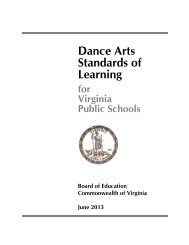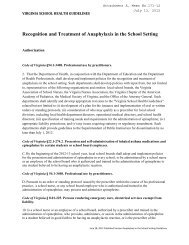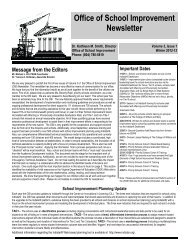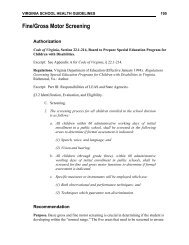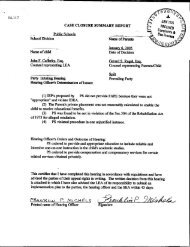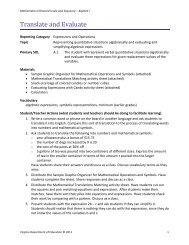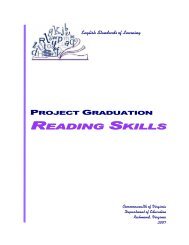Know the warning signs of educator sexual misconduct - Virginia ...
Know the warning signs of educator sexual misconduct - Virginia ...
Know the warning signs of educator sexual misconduct - Virginia ...
Create successful ePaper yourself
Turn your PDF publications into a flip-book with our unique Google optimized e-Paper software.
Sex and schools<br />
<strong>Know</strong> <strong>the</strong><br />
<strong>warning</strong><br />
<strong>signs</strong> <strong>of</strong><br />
<strong>educator</strong><br />
<strong>sexual</strong><br />
<strong>misconduct</strong><br />
Educators can prevent much <strong>of</strong><br />
<strong>the</strong> <strong>sexual</strong> <strong>misconduct</strong> in schools<br />
if <strong>the</strong>y know how to recognize<br />
and respond to suspicious<br />
patterns and if administrators<br />
enforce an environment <strong>of</strong> high<br />
expectations for behavior.<br />
By Charol Shakeshaft<br />
You’ve seen <strong>the</strong> headlines and watched<br />
stories unfold on TV. A local <strong>educator</strong> is arrested<br />
and charged with <strong>sexual</strong> contact with<br />
a student. Sometimes, <strong>the</strong> <strong>educator</strong> is a man;<br />
sometimes, a woman. The person charged<br />
might be a teacher, an aide, a principal, a<br />
coach, <strong>the</strong> band director, or any o<strong>the</strong>r adult<br />
in <strong>the</strong> school.<br />
According to <strong>the</strong> most recent data from<br />
a nationwide survey <strong>of</strong> 8th- to 11th-grade<br />
CHAROL SHAKESHAFT is a pr<strong>of</strong>essor <strong>of</strong><br />
educational leadership at <strong>Virginia</strong> Commonwealth<br />
University, Richmond, Va.<br />
8 Kappan February 2013
Comments?<br />
Like PDK at www.<br />
facebook.com/pdkintl<br />
students asking about incidents <strong>of</strong> unwanted <strong>sexual</strong><br />
attention at school, nearly 7%, or about 3.5 million<br />
students, report having physical <strong>sexual</strong> contact from<br />
an adult, most commonly a teacher or coach, in <strong>the</strong>ir<br />
school (Shakeshaft, 2004). These students describe<br />
unwanted touching on breasts, buttocks, and genitals;<br />
forced kissing and hugging; oral/genital contact;<br />
and vaginal and anal intercourse.<br />
Reports <strong>of</strong> <strong>educator</strong> <strong>misconduct</strong> that doesn’t include<br />
touching a student, but ra<strong>the</strong>r sharing pornography,<br />
<strong>sexual</strong> talk, <strong>sexual</strong> exhibitionism, or masturbation<br />
raised <strong>the</strong> proportion to about 10%, or nearly<br />
4.5 million students (Shakeshaft, 2004).<br />
I coined <strong>the</strong> phrase <strong>educator</strong> <strong>sexual</strong> <strong>misconduct</strong> at<br />
least a decade ago because it brackets a range <strong>of</strong> inappropriate<br />
to criminal <strong>sexual</strong> behaviors and includes<br />
verbal, visual, and physical <strong>misconduct</strong>. Some <strong>of</strong> this<br />
behavior is criminal, some not. But all <strong>of</strong> <strong>the</strong> behaviors<br />
are unacceptable when directed by an adult,<br />
especially by a school-based authority figure, toward<br />
a student.<br />
While predators are <strong>the</strong> adults who abuse, adult<br />
bystanders also contribute to an unsafe environment.<br />
When I talk with teachers in schools where<br />
an abuser has been arrested, I hear admissions that<br />
<strong>the</strong>y had suspected something but, because <strong>the</strong>y were<br />
not completely sure, did not want to say anything. A<br />
common explanation for not reporting questionable<br />
behavior is, “If I reported and I was wrong, I would<br />
have ruined <strong>the</strong> life <strong>of</strong> ano<strong>the</strong>r teacher.” I have never<br />
heard a colleague say, “If I didn’t report and this person<br />
had abused, I’d have ruined <strong>the</strong> life <strong>of</strong> a student.”<br />
The number <strong>of</strong> students abused is high, especially<br />
where prevention is spotty or absent. Most <strong>educator</strong>s,<br />
parents, and students don’t know <strong>the</strong> <strong>warning</strong><br />
<strong>signs</strong> and patterns <strong>of</strong> <strong>educator</strong> abusers. If <strong>the</strong>y did,<br />
<strong>the</strong>y’d be more likely to report and <strong>the</strong>refore prevent<br />
harm to children.<br />
It is ironic, if not indeed tragic, that most programs<br />
to stop <strong>sexual</strong> abuse are directed toward children,<br />
asking <strong>the</strong>m to do what adults will not — report.<br />
While children must learn risky situation identification,<br />
refusal, and disclosure skills, adults — not<br />
children — are responsible for ensuring that schools<br />
are safe places for all students.<br />
Patterns <strong>of</strong> <strong>sexual</strong> <strong>misconduct</strong><br />
While <strong>the</strong>re are no screening tools to help determine<br />
who is an active or potential <strong>sexual</strong> predator,<br />
school leaders can learn to read <strong>the</strong> <strong>warning</strong> <strong>signs</strong> and<br />
patterns that identify risk and boundary behavior.<br />
The descriptions that follow are archetypes summa-<br />
rized from scores <strong>of</strong> court cases and from <strong>the</strong> empirical<br />
literature. I <strong>of</strong>fer generalizations because <strong>the</strong>y’re<br />
grounded in <strong>the</strong> reality <strong>of</strong> school-based <strong>sexual</strong> abuse<br />
and, to that extent, may help caring <strong>educator</strong>s understand<br />
and act on this circumstance.<br />
I’ve identified two predominant types <strong>of</strong> predators<br />
in schools. The first is <strong>the</strong> fixated abuser who is<br />
most <strong>of</strong>ten found in elementary schools and <strong>the</strong> early<br />
middle school grades. This person is more likely<br />
to be male than female and is likely to be judged a<br />
good teacher by parents, students, o<strong>the</strong>r teachers,<br />
and administrators. Fixated abusers have a disproportionate<br />
number <strong>of</strong> teaching awards. This should<br />
not be interpreted as meaning that outstanding and<br />
awarded teachers are child <strong>sexual</strong> abusers, but ra<strong>the</strong>r<br />
that most fixated abusers in elementary school are<br />
considered to be excellent teachers by <strong>the</strong> school<br />
community.<br />
While predators are <strong>the</strong> adults<br />
who abuse, adult bystanders<br />
also contribute to an unsafe<br />
environment.<br />
A typical pattern in an elementary school is an<br />
outstanding male teacher who identifies a male student<br />
as a possible victim. The predator talks with<br />
<strong>the</strong> boy, has him stay after school for extra help, and<br />
gives him small gifts. If <strong>the</strong> child doesn’t resist, <strong>the</strong>n<br />
<strong>the</strong> teacher contacts <strong>the</strong> parent, <strong>of</strong>ten <strong>the</strong> mo<strong>the</strong>r<br />
in a single-parent home, and tells her that her son<br />
has a lot <strong>of</strong> promise, but needs some extra help. The<br />
teacher is soon at <strong>the</strong> child’s home, working with<br />
<strong>the</strong> child. The mo<strong>the</strong>r might feel a sense <strong>of</strong> relief,<br />
knowing that a respected teacher has reached out<br />
to help her son. She’s <strong>of</strong>ten grateful for <strong>the</strong> presence<br />
<strong>of</strong> a positive male role model. The teacher has<br />
now secured <strong>the</strong> trust <strong>of</strong> <strong>the</strong> mo<strong>the</strong>r. He already had<br />
trust at school because <strong>of</strong> his reputation as a good<br />
teacher and a helpful and caring colleague. This<br />
predator begins to take <strong>the</strong> male student to special<br />
places — ball games, fishing, camping — that give<br />
him private access to <strong>the</strong> child. The teacher shows<br />
<strong>the</strong> child affection, tells him how much he cares,<br />
and escalates touching. When <strong>the</strong> teacher predator<br />
<strong>sexual</strong>ly abuses <strong>the</strong> student, he does so in an environment<br />
in which he feels safe. He is respected at<br />
school, <strong>the</strong> family knows him and trusts him, and<br />
<strong>the</strong> child is available to him.<br />
A different pattern at <strong>the</strong> elementary level is<br />
for a male teacher to choose a female student as a<br />
* Deepen your<br />
understanding <strong>of</strong><br />
this article with<br />
questions and<br />
activities in this<br />
month’s Kappan<br />
Pr<strong>of</strong>essional<br />
Development<br />
Discussion<br />
Guide by Lois<br />
Brown Easton.<br />
Download <strong>the</strong><br />
guide at kappan<br />
magazine.org.<br />
V94 N5 kappanmagazine.org 9
class monitor or class helper. For example, a music<br />
teacher might select one <strong>of</strong> <strong>the</strong> outstanding musicians<br />
and tell her she’s more capable than o<strong>the</strong>rs in<br />
<strong>the</strong> class. He compliments her maturity and has her<br />
stay after school. Soon, <strong>the</strong> female student and <strong>the</strong><br />
teacher are well known to each o<strong>the</strong>r. The teacher<br />
continues to flatter and charm, and <strong>the</strong> girl feels<br />
special. Soon, <strong>the</strong> teacher touches <strong>the</strong> girl and, over<br />
time, increases <strong>the</strong> <strong>sexual</strong> nature <strong>of</strong> <strong>the</strong> touch. By<br />
this time, <strong>the</strong> child trusts and cares for <strong>the</strong> teacher,<br />
and <strong>the</strong> teacher exploits that trust and <strong>sexual</strong>ly victimizes<br />
<strong>the</strong> student.<br />
Anna Salter, an internationally known expert on<br />
<strong>sexual</strong> predators, recently reminded us that fixated<br />
abusers work hard to be likeable. Popularity and<br />
likability are <strong>of</strong>ten confused with trustworthiness.<br />
When a fixated abuser is accused, victims protect<br />
<strong>the</strong>m, parents refuse to believe <strong>the</strong> accusations, authorities<br />
discount <strong>the</strong> reports, communities support<br />
<strong>the</strong> predator, and juries acquit (Salter, 2012).<br />
Most programs to stop <strong>sexual</strong><br />
abuse are directed toward<br />
children, asking <strong>the</strong>m to do what<br />
adults will not — report.<br />
School faculty and staff <strong>of</strong>ten rally around a<br />
teacher accused <strong>of</strong> <strong>sexual</strong> <strong>misconduct</strong> while shunning<br />
and shaming <strong>the</strong> victim. Even when <strong>the</strong> accused<br />
admits <strong>the</strong> crime, colleagues have been charmed and<br />
groomed to such a degree that some conclude <strong>the</strong><br />
predator confessed to spare family and friends <strong>the</strong><br />
embarrassment <strong>of</strong> a public trial.<br />
While fixated abusers are difficult to detect because<br />
<strong>the</strong>y get parents, children, and o<strong>the</strong>r <strong>educator</strong>s<br />
to trust <strong>the</strong>m, <strong>the</strong>y can be stopped if administrators<br />
and o<strong>the</strong>r teachers understand <strong>the</strong> patterns and are<br />
willing to act. In most cases, reporting suspicions to<br />
a child protection agency and/or <strong>the</strong> police will lead<br />
to an investigation that will explore <strong>the</strong> possibility <strong>of</strong><br />
abuse. While not all investigations accurately identify<br />
abusers, many do. Moreover, a complaint and<br />
investigation record alerts school personnel to keep<br />
an eye on <strong>the</strong> alleged predator and to make connections<br />
with future allegations.<br />
But fixated abusers are not <strong>the</strong> majority <strong>of</strong> those<br />
who <strong>sexual</strong>ly victimize students. Only about onethird<br />
<strong>of</strong> <strong>of</strong>fenders who abuse children under 13 are<br />
fixated abusers. The remainder who target <strong>the</strong> o<strong>the</strong>r<br />
two-thirds <strong>of</strong> children under 13 and most students<br />
older than 13 are opportunistic abusers. These are<br />
adults who take <strong>sexual</strong> advantage <strong>of</strong> a situation, but<br />
who aren’t exclusively attracted to children or teenagers.<br />
These adults tend to be emotionally arrested<br />
and operate at a teenage level. They are adults who<br />
have boundary and judgment problems and aren’t<br />
difficult to identify once <strong>the</strong>ir patterns are familiar<br />
to o<strong>the</strong>rs in <strong>the</strong> school.<br />
A typical example is <strong>the</strong> case <strong>of</strong> a 6th-grade girl<br />
whose friend reported <strong>the</strong> abuse, ultimately leading<br />
to <strong>the</strong> teacher’s arrest. O<strong>the</strong>r teachers wore armbands<br />
in support <strong>of</strong> <strong>the</strong>ir colleague and collected<br />
money from students and parents to support his legal<br />
defense, including collecting money in <strong>the</strong> female<br />
victim’s classroom, in front <strong>of</strong> her. O<strong>the</strong>r teachers<br />
called her a “slut” and accused her <strong>of</strong> “trying to ruin<br />
<strong>the</strong> career <strong>of</strong> a good man.” The accused teacher confessed<br />
to <strong>sexual</strong>ly abusing <strong>the</strong> student. The female<br />
victim left <strong>the</strong> school because she was harassed daily<br />
by adults and students. Although <strong>the</strong> teacher was<br />
arrested and lost his teaching license, <strong>the</strong> treatment<br />
<strong>of</strong> <strong>the</strong> victim by o<strong>the</strong>r adults in <strong>the</strong> school caused<br />
additional damage.<br />
Although students report that instances <strong>of</strong> <strong>educator</strong><br />
<strong>sexual</strong> <strong>misconduct</strong> by adult males are 4.5 times<br />
more likely than instances <strong>of</strong> abuse by females, 40%<br />
<strong>of</strong> <strong>the</strong> reported <strong>misconduct</strong> was from a female working<br />
in <strong>the</strong> schools (Shakeshaft, 2004). Females frequently<br />
attribute <strong>the</strong>ir <strong>misconduct</strong> to romantic love<br />
for a male student, playing out a redo <strong>of</strong> <strong>the</strong>ir own<br />
adolescent fantasies. For instance, a female teacher<br />
with a weak self-image might be attracted to a male<br />
student in her class and feel excited when she talks<br />
with him. She starts to think that pursuing him is acceptable<br />
because he’s a teenager. She flatters him and<br />
makes herself <strong>sexual</strong>ly available. The male student<br />
might be anxious and repelled or pleased by such attention.<br />
Ei<strong>the</strong>r way, social and cultural norms have<br />
taught <strong>the</strong> young man that he is supposed to feel<br />
honored and engage in a <strong>sexual</strong> relationship. And so,<br />
he acquiesces to <strong>the</strong> female teacher. A similar pattern<br />
is a male teacher who finds a female student attractive.<br />
He courts her, flirts with her, and romances her.<br />
The female student is thrilled that a teacher thinks<br />
she’s smart, mature, and attractive. She thinks <strong>the</strong>y’re<br />
dating and in love.<br />
The opportunistic abusers tend to spend a lot <strong>of</strong><br />
time around groups <strong>of</strong> students, talking with <strong>the</strong>m,<br />
going to <strong>the</strong> same places <strong>the</strong>y go, and trying to blend<br />
in. They are <strong>the</strong> teachers who want to be seen as<br />
hip or cool and who want <strong>the</strong> students to think <strong>the</strong>y<br />
are part <strong>of</strong> <strong>the</strong> student peer group. They are adults<br />
who comment on <strong>the</strong> attractiveness <strong>of</strong> <strong>the</strong> students,<br />
talking about a student as hot or sexy. Their conversations<br />
about students are <strong>of</strong>ten inappropriately<br />
personal. They also know a great deal about <strong>the</strong> personal<br />
lives <strong>of</strong> individual students, more than would<br />
10 Kappan February 2013
e available to an adult whose interactions were academic<br />
or appropriately friendly.<br />
Environment in which abuse occurs<br />
According to David Finkelhor, director <strong>of</strong> <strong>the</strong><br />
Crimes against Children Research Center at <strong>the</strong><br />
University <strong>of</strong> New Hampshire, four preconditions<br />
facilitate <strong>educator</strong> <strong>sexual</strong> <strong>misconduct</strong>.<br />
• The adult must be motivated to <strong>sexual</strong>ly abuse<br />
a child. This motivation might be <strong>the</strong> <strong>sexual</strong><br />
arousal <strong>of</strong> a fixated abuser or <strong>the</strong> happenstance<br />
that prompts an opportunistic abuser.<br />
• The adult must overcome both internal and<br />
external inhibitions against abuse.<br />
• The adult must have an opportunity to engage<br />
in <strong>sexual</strong> activity.<br />
• The adult must overcome <strong>the</strong> child’s resistance.<br />
Motivation to <strong>sexual</strong>ly abuse. No screening devices<br />
will identify a fixated abuser nor is <strong>the</strong>re a<br />
treatment that will change <strong>the</strong> <strong>sexual</strong> desire <strong>of</strong> a<br />
fixated abuser. But schools can create an environment<br />
that discourages child <strong>sexual</strong> abusers. This is<br />
true for both fixated and opportunistic <strong>of</strong>fenders.<br />
Close supervision, a series <strong>of</strong> policies and regulations<br />
that reduce risk, and <strong>the</strong> commitment <strong>of</strong> all<br />
staff in a school to protect children — proactively<br />
and especially through reporting — can make it<br />
difficult for a fixated abuser to groom and abuse<br />
children. The same is true for <strong>the</strong> opportunistic<br />
<strong>of</strong>fender, who takes advantage <strong>of</strong> situations that<br />
are generally prevented or proscribed in well-run,<br />
closely supervised schools.<br />
Internal inhibitors. Predators don’t want to be<br />
caught. Fear <strong>of</strong> arrest and prison can derail <strong>the</strong> motivation<br />
to abuse. Policies and procedures that make<br />
it clear that child <strong>sexual</strong> abuse is a criminal act and<br />
that <strong>educator</strong> <strong>sexual</strong> <strong>misconduct</strong> can lead both to<br />
termination <strong>of</strong> a teaching career and prison time go<br />
a long way to prevent abuse. Making consequences<br />
clear and operating with zero tolerance for <strong>educator</strong><br />
<strong>sexual</strong> <strong>misconduct</strong> impedes abuse. Predators rationalize<br />
<strong>the</strong>ir actions by using thinking errors such<br />
as “She wanted me to do those things to her.” “I’m<br />
helping him to grow up.” “She flirted with me.” “He<br />
knew what he was doing.” “He liked it.” “She wanted<br />
it.” It is possible to provide training that clarifies<br />
<strong>the</strong> criminal consequences <strong>of</strong> such rationalizations.<br />
The climate established by that effective pr<strong>of</strong>essional<br />
learning <strong>the</strong>n provides an additional defense against<br />
abuse.<br />
External inhibitors. Good policies and procedures,<br />
annual training, clarity about boundaries, parent<br />
awareness, and staff vigilance — <strong>the</strong>se all work<br />
to minimize abuse. <strong>Know</strong>ing that o<strong>the</strong>r teachers and<br />
personnel will report inappropriate or questionable<br />
behavior also can inhibit an adult from inappropriate<br />
behavior with students. Unfortunately, only 11% <strong>of</strong><br />
teachers say <strong>the</strong>y would report abuse <strong>of</strong> a student by<br />
a fellow teacher (Shakeshaft, 2004). Students who<br />
don’t report are <strong>of</strong>ten embarrassed, ashamed, and/<br />
or afraid <strong>the</strong>y will be blamed. They also believe that<br />
school <strong>of</strong>ficials will do nothing to help <strong>the</strong>m. Some<br />
want <strong>the</strong> abuse to stop, but don’t want <strong>the</strong> abuser to<br />
get in trouble.<br />
Child resistance. Children should learn how to<br />
refuse inappropriate behavior and how to report such<br />
activity. However, even <strong>the</strong> best training is no match<br />
for a determined predator, and streng<strong>the</strong>ning student<br />
skills is not a substitute for adult responsibility.<br />
Creating a safe environment<br />
Keith Kaufman, pr<strong>of</strong>essor <strong>of</strong> psychology at Portland<br />
State University, advocates a situational prevention<br />
approach to preventing <strong>sexual</strong> abuse by trusted<br />
o<strong>the</strong>rs (2012). With this process approach, schools<br />
and districts assess <strong>the</strong>ir environments for safety risks<br />
and can make necessary improvements.<br />
Careful hiring. While background checks are required<br />
in most states, <strong>the</strong>y rarely flag a <strong>sexual</strong> predator<br />
applying for a pr<strong>of</strong>essional position because<br />
<strong>the</strong>se people are not likely to have a criminal record.<br />
Therefore, it is important to complete careful<br />
reference checks asking direct questions about allegations<br />
<strong>of</strong> <strong>sexual</strong> <strong>misconduct</strong>. Applicants moving<br />
from one district to ano<strong>the</strong>r should be given careful<br />
scrutiny and reference checks should extend beyond<br />
<strong>the</strong> references listed.<br />
Strong policies. Districts should have clear policies<br />
and procedures that systematically and explicitly<br />
detail <strong>the</strong> following:<br />
• What constitutes <strong>educator</strong> <strong>sexual</strong> abuse?<br />
• What are acceptable and unacceptable<br />
behaviors by <strong>educator</strong>s?<br />
• What are <strong>the</strong> mechanisms for legally required<br />
reporting?<br />
• How can students, teachers, administrators, and<br />
parents prevent <strong>educator</strong> <strong>sexual</strong> abuse?<br />
• When and how does <strong>the</strong> school’s or district’s<br />
V94 N5 kappanmagazine.org 11
system for detecting abuse automatically<br />
trigger an investigation and ensure an impartial<br />
investigation?<br />
• What are <strong>the</strong> legal consequences for a<br />
violation?<br />
Stakeholders need policies that define verbal,<br />
visual, and physical <strong>sexual</strong> <strong>misconduct</strong> and make it<br />
clear that <strong>the</strong> district is committed to eliminating<br />
<strong>sexual</strong> exploitation <strong>of</strong> students by adults.<br />
Policies should provide guidance in identifying<br />
and reporting behaviors that might indicate <strong>sexual</strong><br />
exploitation and make it clear that <strong>the</strong> entire school<br />
family is responsible for identification and reporting.<br />
Policies should not only provide direction for<br />
reporting concerns to school district <strong>of</strong>ficials, but<br />
also be clear about requirements for investigating<br />
and reporting to local law enforcement and to state<br />
education <strong>of</strong>ficials who certify and license <strong>educator</strong>s.<br />
Making consequences clear<br />
and operating with zero tolerance<br />
for <strong>educator</strong> <strong>sexual</strong> abuse can<br />
impede abuse.<br />
School and district policies should be published in<br />
staff, student, and parent handbooks, and <strong>the</strong> materials<br />
need to deal directly and explicitly with <strong>educator</strong><br />
or staff <strong>sexual</strong> <strong>misconduct</strong>. Broad statements about<br />
nondiscrimination or child abuse are insufficient to<br />
ensure that staff, parents, and students understand<br />
what constitutes <strong>educator</strong> <strong>sexual</strong> <strong>misconduct</strong> and<br />
<strong>the</strong> procedures necessary to prevent or report adult<br />
<strong>sexual</strong> exploitation <strong>of</strong> students in schools.<br />
Policies should stress that any report, rumor, or<br />
suspicion <strong>of</strong> <strong>sexual</strong> <strong>misconduct</strong> must be reported to<br />
<strong>the</strong> responsible authorities. Policies should stress<br />
that reporting suspected <strong>misconduct</strong> is both a pr<strong>of</strong>essional<br />
responsibility and <strong>the</strong> law. Individuals who<br />
report suspected abuse are not responsible for determining<br />
<strong>the</strong> validity <strong>of</strong> <strong>the</strong> suspicion — that’s <strong>the</strong><br />
role <strong>of</strong> <strong>the</strong> subsequent investigation by police or child<br />
service workers.<br />
School districts should identify a central source<br />
— an <strong>of</strong>fice or a person with a specific title — that<br />
is responsible for receiving all reports <strong>of</strong> <strong>educator</strong><br />
<strong>sexual</strong> <strong>misconduct</strong>. This helps avoid situations in<br />
which reports are overlooked or patterns unidentified.<br />
Directing all complaints to a single source helps<br />
ensure that all allegations are investigated and that<br />
histories <strong>of</strong> complaints are compiled.<br />
Finally, policies must stress that even acts <strong>of</strong> <strong>sexual</strong><br />
<strong>misconduct</strong> that do not break <strong>the</strong> law will not be tolerated<br />
and can lead to termination <strong>of</strong> employment.<br />
Environmental monitoring. Creating a safe environment<br />
means changing <strong>the</strong> school culture and<br />
enlisting everyone in assessing risk. Identify areas <strong>of</strong><br />
potential risks. Classroom doors should have glass<br />
windows, and <strong>the</strong>y should never be covered. Locked<br />
classrooms, storerooms, and teacher <strong>of</strong>fices are all<br />
places where <strong>sexual</strong> <strong>misconduct</strong> occurs, <strong>of</strong>ten before<br />
or after school. They need to be secured. A staff<br />
person should be assigned to check classrooms at<br />
<strong>the</strong> end <strong>of</strong> each school day to ensure that <strong>the</strong>y’re<br />
empty and that students have left <strong>the</strong> building unless<br />
<strong>the</strong>y are in approved activities. Any before- or<br />
after-school tutoring should occur in a public and<br />
supervised location.<br />
Environmental monitoring also relates to employee<br />
behaviors. Are <strong>the</strong>re staff who consistently<br />
cross boundaries, <strong>sexual</strong> or not? Or who are emotionally<br />
needy or who spend most <strong>of</strong> <strong>the</strong>ir free time<br />
with students? Do some school personnel hang out<br />
with middle or high school students regularly? Do<br />
employees know and follow <strong>the</strong> prohibition against<br />
being alone with a child or taking a child in a car?<br />
Safe schools are places where administrators and<br />
teachers know what is happening in <strong>the</strong> next classroom,<br />
down <strong>the</strong> hall, and before and after school.<br />
Training and education. Even <strong>the</strong> best policies<br />
won’t work unless staff, students, and parents understand<br />
<strong>the</strong> expectations <strong>of</strong> <strong>the</strong> district. Training<br />
needs to be done with all staff — pr<strong>of</strong>essional and<br />
nonpr<strong>of</strong>essional workers — as well as with students<br />
and parents, and <strong>the</strong> training must be repeated annually.<br />
Annual training ensures that new students and<br />
new teachers are aware <strong>of</strong> <strong>the</strong> policies and reminds<br />
veteran staff <strong>of</strong> <strong>the</strong>ir responsibilities. A one-time<br />
workshop will not prevent <strong>sexual</strong> <strong>misconduct</strong>. Prevention<br />
requires a combination <strong>of</strong> annual workshops<br />
for staff, students, and parents that focus specifically<br />
on <strong>sexual</strong> exploitation <strong>of</strong> students, written materials<br />
in policy books and manuals, posters and flyers that<br />
remind students and staff about appropriate conduct,<br />
and visible information in all department and administrative<br />
<strong>of</strong>fices.<br />
Sexual abuse prevention training is not just for<br />
those who might abuse. Such training also is for<br />
adults and students who are third-party observers.<br />
Staff must understand <strong>the</strong>ir legal responsibilities for<br />
reporting behavior that might indicate <strong>sexual</strong> <strong>misconduct</strong><br />
<strong>of</strong> staff toward students and learn <strong>the</strong> consequences<br />
for <strong>the</strong>ir failure to report. Training should<br />
deal with <strong>the</strong> “it can’t happen here” syndrome <strong>of</strong><br />
denial by discussing specific situations and incidents<br />
12 Kappan February 2013
that have previously occurred at <strong>the</strong> school or in <strong>the</strong><br />
district. If an incident is in <strong>the</strong> public sphere (newspaper<br />
or trial accounts), staff can discuss it in training<br />
sessions. If <strong>the</strong> incident has not been made public,<br />
staff can still use it as an example or a case study, without<br />
names, in discussions during department, gradelevel,<br />
and o<strong>the</strong>r staff meetings. The more local and<br />
specific <strong>the</strong> training is, <strong>the</strong> more effective it will be.<br />
If an incident <strong>of</strong> <strong>educator</strong> <strong>sexual</strong> abuse does occur<br />
in a school or district, <strong>the</strong> school and district should<br />
immediately conduct a root cause analysis to prevent<br />
system and personal failure in <strong>the</strong> future.<br />
Consistent messaging. The message is that <strong>the</strong><br />
school and district won’t tolerate <strong>educator</strong> <strong>sexual</strong><br />
<strong>misconduct</strong>. In order for <strong>the</strong> message to be believed,<br />
schools and districts must act when confronted with<br />
suspicious behavior. Most students and staff members<br />
believe that districts won’t do anything about<br />
<strong>sexual</strong> <strong>misconduct</strong>. Students <strong>of</strong>ten see cover-ups<br />
even when <strong>the</strong>y don’t exist, and, for some sad but<br />
good reasons, most have little faith that school personnel<br />
will take <strong>the</strong>ir complaints seriously. Because<br />
<strong>of</strong> this lack <strong>of</strong> faith in school district personnel, many<br />
students and staff members won’t report incidents.<br />
Administrative actions need to be communicated to<br />
<strong>the</strong> school community to send <strong>the</strong> message that reports<br />
<strong>of</strong> <strong>sexual</strong> <strong>misconduct</strong> are taken seriously.<br />
Consistent enforcement requires that administrators<br />
and o<strong>the</strong>r staff members listen to rumors and<br />
complaints and respond by investigating and following<br />
up. Reports <strong>of</strong> inappropriate <strong>sexual</strong> behavior are<br />
more likely to come from a friend or parent <strong>of</strong> a<br />
student than from <strong>the</strong> student her or himself. Such<br />
reports may be tentative, with disclaimers such as<br />
“I’m probably making too much <strong>of</strong> this” or “I may<br />
be overreacting.”<br />
Students who report <strong>sexual</strong> <strong>misconduct</strong> by teachers<br />
are likely to be harassed by o<strong>the</strong>r students and<br />
by teachers, especially if <strong>the</strong> accused is a popular<br />
teacher. They may also come from homes in which<br />
little support will be available to <strong>the</strong>m during this<br />
stressful time, although this is not always <strong>the</strong> case.<br />
District <strong>of</strong>ficials must ensure that students who report<br />
abuse are <strong>the</strong>mselves protected from harassment,<br />
and <strong>the</strong> districts also must provide support<br />
systems for student victims.<br />
Preventing <strong>sexual</strong> <strong>misconduct</strong><br />
Schools are microcosms <strong>of</strong> society. Regrettably,<br />
society has not been effective in protecting<br />
children from <strong>the</strong> epidemic <strong>of</strong> child <strong>sexual</strong> abuse.<br />
Child <strong>sexual</strong> abuse has been described as a preventable<br />
health problem. A 2012 report from <strong>the</strong><br />
Centers for Disease Control and Prevention found<br />
that <strong>the</strong> estimated average lifetime cost per victim<br />
<strong>of</strong> nonfatal child maltreatment (which includes<br />
<strong>sexual</strong> abuse) is $210,012. If we multiply that by<br />
<strong>the</strong> 3.5 million students currently in school who<br />
report physical <strong>educator</strong> <strong>sexual</strong> <strong>misconduct</strong>, <strong>the</strong><br />
result is more than $735 billion (Fanga, Brown,<br />
Florencea, & Mercya, 2012). And that’s just for<br />
<strong>the</strong> students currently in school.<br />
The personal costs <strong>of</strong> <strong>educator</strong> <strong>sexual</strong> <strong>misconduct</strong><br />
are tragic. The Adverse Childhood Experiences Study<br />
found that victims <strong>of</strong> <strong>sexual</strong> abuse are more likely than<br />
nonvictims to have problems with adult relationships,<br />
a history <strong>of</strong> drug or alcohol abuse, <strong>the</strong> risk <strong>of</strong> suicide<br />
or o<strong>the</strong>r harm, and health problems such as diabetes<br />
and heart disease (Dube et al., 2005).<br />
The cost <strong>of</strong> awards or settlements to schools<br />
ranges from hundreds <strong>of</strong> thousands <strong>of</strong> dollars to<br />
millions <strong>of</strong> dollars, which does not include <strong>the</strong> legal<br />
and personnel costs to <strong>the</strong> school district in<br />
civil cases. For instance, I examined settlements in<br />
teacher <strong>sexual</strong> <strong>misconduct</strong> in California between<br />
2002 and 2008 and found that <strong>the</strong> average settlement<br />
was $2,723,000, with awards from $892,000<br />
to $6,800,000.<br />
And <strong>the</strong>n <strong>the</strong>re is <strong>the</strong> loss <strong>of</strong> trust. Schools are<br />
places where parents send <strong>the</strong>ir children to learn.<br />
They expect those places to be safe and nurturing.<br />
While most teachers or school staff members don’t<br />
<strong>sexual</strong>ly abuse children, many do. It is possible to<br />
prevent abuse. We know how to do it; we only need<br />
<strong>the</strong> will to do it.<br />
K<br />
References<br />
Dube, S.R., Anda, R.F., Whitfi eld, C.L., Brown, D.W., Felitti,<br />
V.J., Dong, M., & Giles, W.H. (2005). Long-term consequences<br />
<strong>of</strong> childhood <strong>sexual</strong> abuse by gender <strong>of</strong> victim. American<br />
Journal <strong>of</strong> Preventative Medicine, 28 (5), 430-438.<br />
Fanga, X., Brown, D.S., Florencea, C.S., & Mercya, J.A.<br />
(2012). The economic burden <strong>of</strong> child maltreatment in <strong>the</strong><br />
United States and implications for prevention. Child Abuse and<br />
Neglect, 36 (2), 156-165.<br />
Kaufman, K. (2012, November 1). Situational prevention<br />
<strong>of</strong> child <strong>sexual</strong> abuse. Presentation to <strong>the</strong> National Youth<br />
Protection Symposium, Atlanta, Ga.<br />
Salter, A. (2012, November 1). Sex <strong>of</strong>fenders, adult behavior<br />
and grooming. Presentation to <strong>the</strong> National Youth Protection<br />
Symposium, Atlanta, GA.<br />
Shakeshaft, C. (2004). Educator <strong>sexual</strong> <strong>misconduct</strong>.<br />
Washington, DC: U.S. Department <strong>of</strong> Education.<br />
V94 N5 kappanmagazine.org 13






